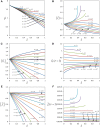Hydrodynamics of steady state phloem transport with radial leakage of solute
- PMID: 24409189
- PMCID: PMC3872826
- DOI: 10.3389/fpls.2013.00531
Hydrodynamics of steady state phloem transport with radial leakage of solute
Abstract
Long-distance phloem transport occurs under a pressure gradient generated by the osmotic exchange of water associated with solute exchange in source and sink regions. But these exchanges also occur along the pathway, and yet their physiological role has almost been ignored in mathematical models of phloem transport. Here we present a steady state model for transport phloem which allows solute leakage, based on the Navier-Stokes and convection-diffusion equations which describe fluid motion rigorously. Sieve tube membrane permeability P s for passive solute exchange (and correspondingly, membrane reflection coefficient) influenced model results strongly, and had to lie in the bottom range of the values reported for plant cells for the results to be realistic. This smaller permeability reflects the efficient specialization of sieve tube elements, minimizing any diffusive solute loss favored by the large concentration difference across the sieve tube membrane. We also found there can be a specific reflection coefficient for which pressure profiles and sap velocities can both be similar to those predicted by the Hagen-Poiseuille equation for a completely impermeable tube.
Keywords: fluid dynamics; navier-stokes equation; phloem transport; sieve tube; solute exchange.
Figures





Similar articles
-
Computational models evaluating the impact of sieve plates and radial water exchange on phloem pressure gradients.Plant Cell Environ. 2019 Feb;42(2):466-479. doi: 10.1111/pce.13414. Epub 2018 Sep 24. Plant Cell Environ. 2019. PMID: 30074610
-
Direct measurements of sieve element hydrostatic pressure reveal strong regulation after pathway blockage.Funct Plant Biol. 2004 Nov;31(10):987-993. doi: 10.1071/FP04058. Funct Plant Biol. 2004. PMID: 32688967
-
Revisiting the Münch pressure-flow hypothesis for long-distance transport of carbohydrates: modelling the dynamics of solute transport inside a semipermeable tube.J Exp Bot. 2002 Jun;53(373):1411-9. J Exp Bot. 2002. PMID: 12021288
-
Osmosis and solute-solvent drag: fluid transport and fluid exchange in animals and plants.Cell Biochem Biophys. 2005;42(3):277-345. doi: 10.1385/CBB:42:3:277. Cell Biochem Biophys. 2005. PMID: 15976460 Review.
-
Sieve element occlusion: Interactions with phloem sap-feeding insects. A review.J Plant Physiol. 2022 Feb;269:153582. doi: 10.1016/j.jplph.2021.153582. Epub 2021 Dec 5. J Plant Physiol. 2022. PMID: 34953413 Review.
Cited by
-
Modelling the physiological relevance of sucrose export repression by an Flowering Time homolog in the long-distance phloem of potato.Plant Cell Environ. 2021 Mar;44(3):792-806. doi: 10.1111/pce.13977. Epub 2020 Dec 21. Plant Cell Environ. 2021. PMID: 33314152 Free PMC article.
-
Sweet cherry flesh cells burst in non-random clusters along minor veins.Planta. 2022 Apr 7;255(5):100. doi: 10.1007/s00425-022-03882-7. Planta. 2022. PMID: 35389118 Free PMC article.
References
-
- Benedek G. B., Villars F. M. H. (2000). Physics with Illustrative Examples From Medicine and Biology, 2nd Edn. New York, NY: Springer
-
- Cabrita P. (2011). Experimental and Theoretical Studies of Phloem Transport with the Inclusion of Lateral Solutes Exchange and Apoplastic Conditions. Ph.D. Dissertation, Justus-Liebig-Universität Gießen. Available online at: http://geb.uni-giessen.de/geb/volltexte/2012/8566/
LinkOut - more resources
Full Text Sources
Other Literature Sources
Miscellaneous

